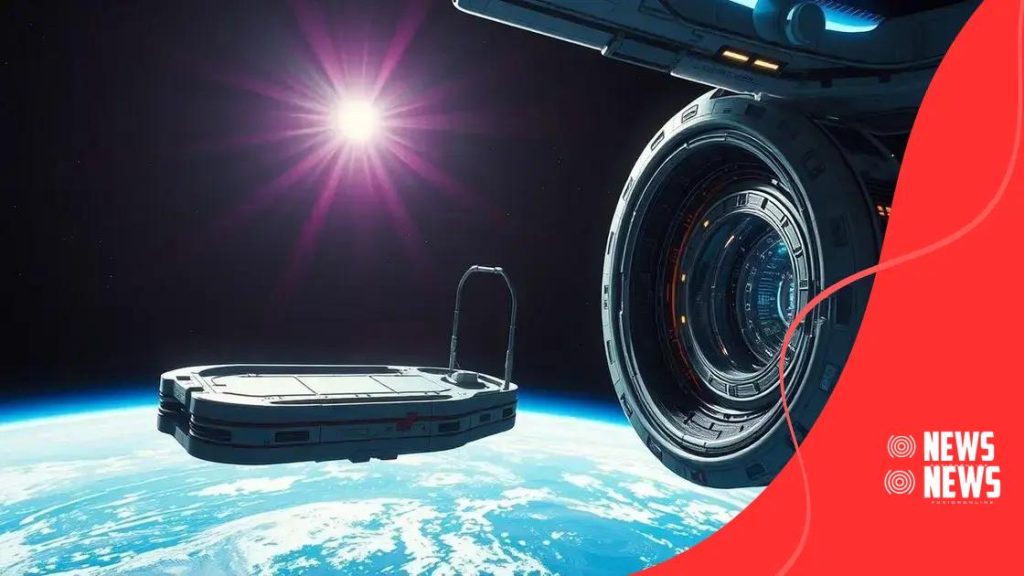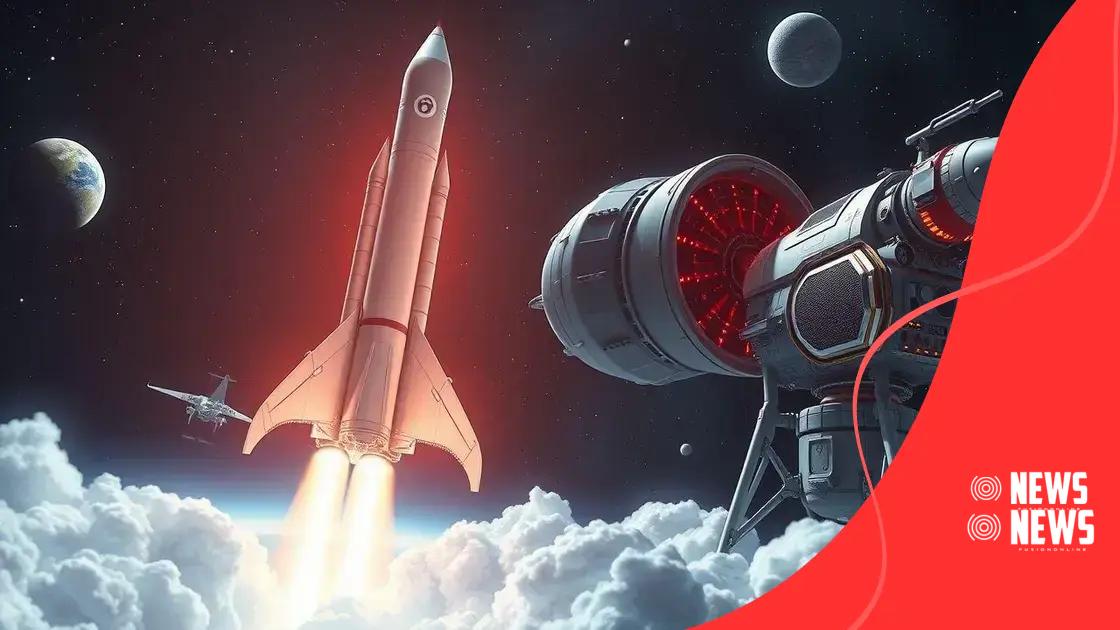Space tourism: the next big leap in exploration

Space tourism is rapidly evolving, with advancements in reusable spacecraft, safety protocols, and sustainable practices, making trips to space more accessible and exciting for future adventurers.
Space tourism is not just a dream anymore; it’s quickly becoming a reality. Imagine gazing at Earth from the cosmos; sounds thrilling, right? Let’s dive into this new frontier.
Understanding the concept of space tourism
Understanding the concept of space tourism is essential for anyone interested in the future of travel. This exciting new frontier allows people to venture beyond Earth and experience the cosmos firsthand. As technology advances, the idea of taking a vacation in space is becoming a reality.
Space tourism refers to commercial activities where individuals pay to travel into space for recreational purposes. Companies like SpaceX, Blue Origin, and Virgin Galactic are at the forefront of this emerging industry, offering suborbital and orbital flights. These companies aim to make space travel accessible to more than just astronauts.
The opportunities in space tourism
Imagine a vacation where you float in microgravity and witness breathtaking views of our planet. The possibilities are endless, and this can be the next step in adventure tourism. Space tourism opens doors to:
- Unique experiences in microgravity
- Stunning views of Earth
- Opportunities for scientific research
- Creation of new markets in space
Moreover, as the industry evolves, we can expect to see advancements in spacecraft design and the overall experience. Companies are continually innovating to enhance the safety and comfort of passengers. With more investments in technology, space tourism is becoming increasingly viable.
The challenges of entering the space tourism market
However, the road to space tourism is not without its challenges. One major issue is cost, as traveling to space remains quite pricey for the average person. But as more companies enter the market, prices may eventually lower. Another concern is the environmental impact of rocket launches. Exploring sustainable methods will be crucial for the industry’s long-term success.
Moreover, safety is of utmost importance. Spacecraft must undergo rigorous testing to ensure passenger protection. Companies are working diligently to address various safety concerns, aiming for a perfect track record as they welcome more travelers into space.
Despite these challenges, the prospect of space tourism continues to inspire people worldwide. The thrill of space travel and the allure of the unknown make it a fascinating topic. As we look to the future, we must keep an eye on innovations in this exciting sector.
Key players in the space tourism industry
Key players in the space tourism industry are transforming the way we think about travel beyond our planet. These companies have laid the groundwork for commercial space flights, making thrilling missions accessible to civilians.
Some of the most notable companies include SpaceX, Blue Origin, and Virgin Galactic. Each of these organizations plays a crucial role in advancing space tourism with innovative technologies and ambitious goals.
SpaceX
Founded by Elon Musk, SpaceX is a leader in space transportation. They have developed the Falcon 9 rocket and the Crew Dragon spacecraft. SpaceX aims to make space travel more routine and affordable. Notably, they have partnered with NASA for various missions and are planning commercial crew flights to the International Space Station.
Blue Origin
Founded by Jeff Bezos, Blue Origin focuses on creating technologies to enable private human access to space. Their New Shepard rocket is designed for suborbital flights, providing passengers with a short experience of weightlessness. The company is committed to building a future where millions of people can live and work in space.
Virgin Galactic
Virgin Galactic, created by Sir Richard Branson, aims to provide commercial space travel to the masses. Their SpaceShipTwo vehicle offers a unique suborbital experience, allowing passengers to see Earth from space. Branson’s vision is to democratize space travel, making it accessible to anyone with the desire for adventure.
Besides these major players, several other companies and startups are emerging in the industry. They are working on different aspects of space tourism, such as orbital hotels and lunar tourism. This diversification shows a growing interest in making space a destination for all.
In addition to these companies, partnerships are forming between private enterprises and government space agencies. Collaborations can help accelerate advancements in safety and technology. As competition heats up, potential customers can expect exciting developments in the coming years.
The technology behind space travel

The technology behind space travel is advancing rapidly, making space tourism a tangible possibility for many. This incredible progress comes from years of research and innovative engineering.
Spacecraft design is crucial for successful missions. The technology used in rockets and spacecraft ensures safety and efficiency during flights. Key components of space travel technology include powerful engines, advanced materials, and life support systems that keep passengers safe and comfortable during their journey.
Rocket engines
Rocket engines provide the thrust needed to escape Earth’s gravity. Most modern rockets use liquid or solid fuel to propel themselves into space. Liquid fuel engines, like those used in SpaceX’s Falcon 9, are known for their efficiency and control. Solid fuel engines are simpler but offer less flexibility in flight.
Spacecraft design
Spacecraft like the Crew Dragon and New Shepard are designed to withstand extreme conditions. They must endure the intense heat during re-entry and the vacuum of space. Designers use materials like carbon fiber and aluminum to build strong yet lightweight structures. Thermal protection systems are also essential to ensure the safety of passengers.
Life support systems
Life support systems are vital for long-duration space travel. These systems provide oxygen, remove carbon dioxide, and regulate temperature. For example, the Environmental Control and Life Support System (ECLSS) on the International Space Station keeps astronauts safe for extended periods. Future spacecraft will need to improve on these technologies to support tourism missions.
Robotics and AI also play crucial roles in space exploration. Robotic systems can perform tasks in space that are too dangerous for humans. They can conduct repairs, gather data, and even assist with landings. AI technology improves navigation and enhances safety by analyzing flight conditions in real-time.
As technology continues to advance, we can expect even more exciting developments in space travel. Innovations in propulsion systems, sustainable fuel options, and spacecraft design will enhance the safety and experience of all future space tourists.
What to expect on your first space trip
What to expect on your first space trip can be both exciting and a little nerve-wracking. Space travel is an extraordinary experience, unlike anything you might have encountered on Earth. Understanding what awaits you will make the journey more enjoyable and less intimidating.
Before liftoff, passengers typically undergo training. This training helps you prepare for what to expect in space, including safety protocols and how to use equipment. It is essential to familiarize yourself with the spacecraft layout and the mission’s timeline. Training often includes simulations, so you feel more comfortable during the actual flight.
The launch experience
The launch is a thrilling moment. You will feel the intense power of the rocket engines as they propel you into the sky. The force of acceleration can be overwhelming at first, but it quickly transforms into weightlessness as you leave Earth’s atmosphere. Many passengers describe the feeling of liftoff as both exhilarating and surreal.
Experiencing microgravity
Once you reach space, you will experience microgravity. This means that you will float instead of feeling your weight. This sensation is both amazing and unusual. You’ll find everyday tasks, like drinking water and using the restroom, are quite different. Spacecraft are equipped with special tools to make these activities easier.
Stunning views from space
One of the highlights of space travel is the breathtaking view of Earth from above. As you gaze out of the window, the planet appears as a beautiful blue marble with swirling clouds. Many passengers say this view changes their perspective on life. Make sure to take plenty of photos, as these memories are priceless.
The duration of a space trip can vary. Suborbital flights might last only a few minutes, while orbital journeys can last several days. During your time in space, you may participate in activities like science experiments, enjoying meals with fellow passengers, or simply taking in the magnificent surroundings.
After experiencing microgravity and the stunning sights, the re-entry process begins. You will need to prepare for the descent back to Earth, where the craft will encounter the atmosphere, often creating a fiery glow. It’s important to follow safety protocols to ensure a smooth landing. The feeling of returning to Earth is a mix of relief and excitement, knowing you have just accomplished something extraordinary.
Future trends in space tourism
Future trends in space tourism promise exciting advancements that will change how we explore the final frontier. As technology evolves and more players enter the market, the concept of space travel becomes more accessible to the general public.
One of the key trends is the development of reusable spacecraft. Companies like SpaceX are paving the way with rockets that can be launched multiple times. This not only cuts costs but also reduces the environmental impact of space travel. Reusable technology is essential for the growth of the space tourism industry.
Orbital and lunar tourism
Another trend is the expansion from suborbital flights to orbital and even lunar tourism. Companies are planning trips that would take tourists around the Moon, giving them a chance to experience deep space. These journeys may include stays at space hotels or stations where guests can enjoy breathtaking views of Earth and the solar system.
Advancements in safety and comfort
Safety continues to be a primary focus. With every new mission, companies are learning more about how to protect passengers during flights. Enhanced training for tourists and the incorporation of more sophisticated technology will improve safety measures. Comfort is also being prioritized, with new spacecraft designs aimed at increasing passenger experience.
Sustainable space travel
Sustainability in space tourism is crucial for its future. As more trips are planned, the industry must address environmental concerns. Innovations in propulsion systems and the use of green fuels are vital for minimizing the ecological footprint. Research into sustainable practices will become increasingly important as space tourism expands.
Moreover, the growing interest in space exploration among private individuals and governments is likely to increase. Partnerships between commercial companies and space agencies will facilitate more ambitious missions. These collaborations may lead to groundbreaking discoveries and experiences for tourists.
Finally, advancements in virtual reality and augmented reality will enhance the space tourism experience. Imagine being able to preview your journey or explore space without leaving Earth. These technologies can provide educational content and thrilling previews that captivate potential travelers.
In conclusion, the future of space tourism is bright and full of possibilities. As technology advances, more people will have the chance to experience the wonders of space. With reusable spacecraft, improved safety measures, and a growing focus on sustainability, the industry is set to thrive. People can look forward to exciting trips to orbital hotels and even lunar excursions in the coming years. The world of space tourism is truly just beginning, and it’s an exciting time for adventurers and dreamers alike!
FAQ – Frequently Asked Questions about Space Tourism
What should I expect during my first space trip?
You can expect an exhilarating launch experience, weightlessness in microgravity, and stunning views of Earth from space.
Are there any safety measures for space tourists?
Yes, companies provide thorough training and implement advanced safety protocols to ensure the well-being of all passengers.
What advancements are being made in space tourism technology?
Improvements include reusable spacecraft, enhanced life support systems, and sustainable fuel options to reduce environmental impact.
Will space tourism become affordable for more people?
As technology advances and more companies enter the market, prices are expected to decrease, making space travel more accessible.





